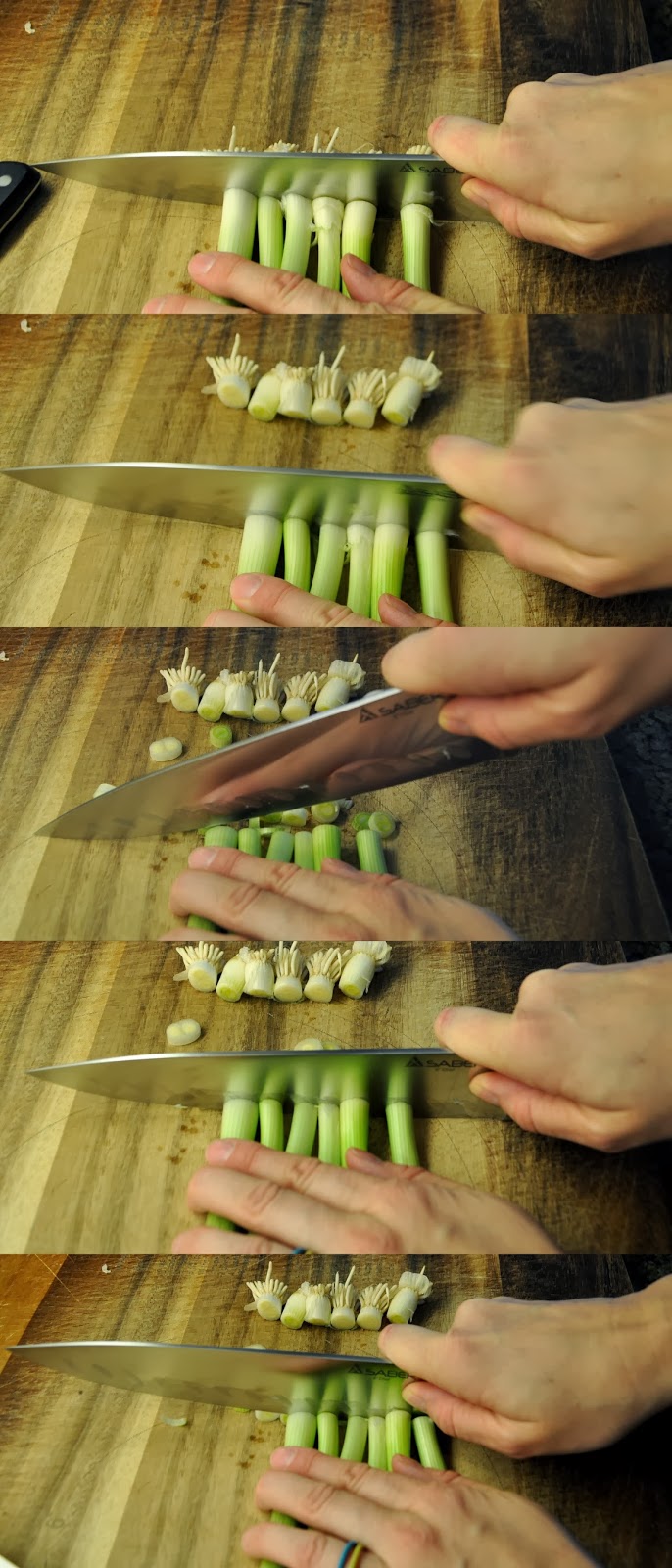I took a class called "Chop Like a Pro!" from the Arkansas Extended Learning Center. After learning these tips/tricks, my prep time in the kitchen has dramatically decreased.
First off- I use a wooden chopping board as it is the softest surface for your knife. I only use the wooden board for chopping veggies- I don't want to cross contaminate raw meats with the board. You could have a board for veggies, one for fruits, and one for meats (I would recommend plastic dishwasher cutting boards for meats though). As for the knife itself, this is a chef's knife. There are other long knives, and you need to find a knife that feels comfortable in your hand. It should feel like an extension of your arm/hand.
Holding the Knife:
You should grip the blade of your knife with your thumb and finger (almost pinching it). It is the most efficient way to hold it. You can hold all knives this same way, regardless of their size. It is most common to find people putting their pointer finger on the top of the knife to push the blade down, but it is much slower and all the strength must come from one finger rather than your hand/arm.
Scallions:
Cut the tops off, then rock your knife and move down the length of the onions. You should lift the handle up, then press down and slide blade away from your body. Practice rocking the knife to see if you like the feel of it.
Dicing/slicing Tomatoes:
If your blade is sharp enough, you can use a chef's knife. Otherwise, you might want to use a serrated knife to cut the skin. Stand the tomato on the stem (it is the most stable surface), and make slices almost all the way through (if you cut all the way through, then it takes forever to dice them all!). Then turn the tomato 90 degrees and slice down almost all the way through. Now turn the tomato on its side to slice into dice. Consistency in size is your goal.
Herbs:
You can cut most stems and use them if you want. I removed the stems here as I didn't need all the cilantro. You want to roughly cut the herbs, then rotate them, cut again, and again and again. You can see that once the herbs get smaller, I switch my hand from a "claw" (with tip of finger tucked in), to a flat hand to assist. You will rock your knife, gather herbs into a pile before rocking your knife through them again.
Bell Peppers (Apples, anything with a core):
There are a few different ways to cut things that have a core, and this one is called the box method. You trim the bottom so it is a stable surface, then take your knife and go around the core. Once all your pieces are off the core, you can slice them as fine/chunky as you would like. Once the bell pepper is off the core, cut into slices with the shiny side on your cutting board (then your knife won't slip off).
Onion:
Cut your onion in half so you have a stable surface. With the stem away from you, slice around the onion (but do not cut all the way through it yet. Keep it intact!). Then put the stem in your non-knife hand and cut toward the stem twice. Now take your knife and cut down to dice your onion. See pictures for better explanation. You can adjust your slices to make them as thick/thin as needed for recipes.
A goal to always keep in mind is consistency. When cooking veggies especially, you want all the pieces to cook at the same rate. If you have some pieces of onion that are really large, and others very small you will have some overcooked and some under cooked. I did not show how to cut mushrooms, carrots, potatoes, etc, but you should be able to apply the above pictured methods to almost any fruit/veggie.
Happy chopping!








What a riveting class name!
ReplyDeleteWe took a class called "Knife Skills" (not nearly so well titled) and really enjoyed it! A good knife does make a world of difference. It looks like we learned many similar things but our chef was very particular about NEVER putting your fingers out on the "holding the food" hand: he always had us put it in a claw shape and come down on our knuckle to avoid losing digits!
This tomato tutorial is very helpful. Thanks!
PS Thank you for taking time to take all these pictures for us. You're a dish.
ReplyDeleteI don't have a wood cutting board. Do you think it is worth it to get one? Do you notice a difference with the knives?
ReplyDeleteI do. It doesn't need to be big (the one I have is extremely large!), but a sharp knife is much safer, more efficient, and more effective at cutting. You can put a damp dishtowel underneath it to keep it from sliding while you cut.
DeleteDo you find that the plastic ones work well? I've never had good luck with a plastic cutting board!
ReplyDeleteYou can put a damp dishtowel underneath it to keep it from sliding while you cut. I use plastic for my meats as the plastic ones can go in the dishwasher!
Delete